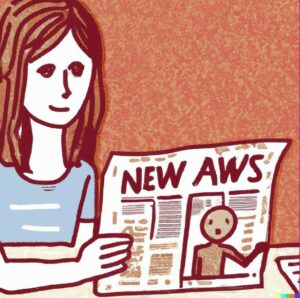The system is the problem, not the technology!
Over the course of 2022, those of us on the internet saw in real time the public launch and subsequent popularity of deep learning (read AI) image generators like Dall-E or Midjourney. Quickly following these programs, repostable infographics and video essays alike began cropping up, attempting to catch up with the ethics, rights, and usage of this quickly evolving technology.
It’s not like this was the launch of brand-new technology; systems like these have been in development since the 1970s and accelerating for the past decade. Something about this development struck a particular nerve, causing the issue to metastasize across our digital forums. In the wake of the epic crashing and burning of the NFT crypto-market, we can fairly assume public wariness of technology and the art market was piqued. The assumed positions of artist versus tech bro were veterans returning to a discourse battle that, this time, would be even less effective for fixing the actual issues of exploitation in the tech.
Any person with a bit of art historical context under their belt is certainly aware that public outrage has been inherent to most developments of artistic style, media, or politics; especially for work that transgresses the enclosure of a gallery into the real world. It’s hard not to draw likenesses from events of art during the Industrial Revolution to now. For instance, when the camera was first made available, painters who had developed techniques of hyperrealistic painting were outraged that their work may become redundant with a photographer’s ability to produce an exact image much quicker. Not only did this not happen, but it also led to a dramatic style shift by forcing painters to produce work that a camera couldn’t.
You might notice this topic is mostly debated on an ambiguous global-ish scale, and this is because the whole turmoil becomes a bit redundant in contexts of Canadian art. Here, not so much is being bought and sold in the artist’s art world as it is being publicly funded, shown, and then stored in someone’s parents’ basement waiting for the next time there’s a call for sparse installations that use found trash as a device for “queering the outdoors.” And there are artists in this model who are using images generated by these sites to an actually engaging effect: the piece We’re all just doing our best (2023), which sold at Mount A’s own Sweetest Little Thing this past February, by Bridget Moser, a Toronto-based performance artist, was printed with the plasticky bubblegum image generated by an AI program. Hannah Epstein, Nova Scotian rug hooker and darling of most local BFA students, and her CritBot.AI have been making the digital rounds of the internet. This is a program that generates art criticism for any image input into the system, with levels of harshness from constructive to merciless.
The real debates of deep learning image-generators softwares that source from public images leads down many rabbit holes of fair-use gray areas, deepfakes, or source imagery being potentials for some pretty on-brand techno-capitalist evil. As with most topics of this brand, these issues boil down to faults in the capitalist system of art and technology that most complainants already suffer under.
The outright refusal of this technology being developed and made publicly available is a bit boring, and the alarmist narrative that AI will replace and make redundant people working and creating art is frankly insulting. For one, labour is valuable; the economic system we live in demands this. Realistic paintings are still highly valued and were not replaced by photos. To the optimist, human touch and thought will always add worth to art in ways that cannot be reproduced or, to the pessimist, capitalism requires that labour be valuable so that the working class can continue to be exploited. The roles and methods of an artist seem to be rigidly constructed with pillars of originality and skilled labour when in fact it is one of the time-honoured traditions of western art to copy and outsource labour. I think the main issue I take, both with critics and defenders of this technology, is that it isn’t being treated as a tool. There are limits to a machine that can only know (not think), but neural networks also contain more information than a person could dream of remembering. As an Artist: these networks seem like another method of generating images, a tool to use alongside other creative methods to produce artwork, and not something that threatens the work I already make.
Dall-E generated image from prompt “student writer produces an ai image to contextualize their article for this newspaper”






